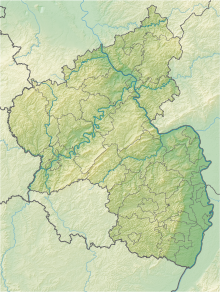Mehlinger Heath
Coordinates: 49 ° 29 ′ 14 ″ N , 7 ° 50 ′ 2 ″ E
The Mehlinger Heide near the Palatinate town of Mehlingen is the largest heathland in southern Germany.
History of origin
The area around Mehlingen was completely covered with forest until 1912. Back then, the forest was not only used for logging, but also
- the production of litter for the cattle in the barn
- as pasture
- to collect firewood and
- for collecting pine cones that were brought to the seed station in Otterberg .
The log books of the Neukirchen community show that at that time there was downright overexploitation in the forests and the forestry office was therefore concerned about the forest. The minutes of the meeting of March 18, 1886 read:
"However, the Otterberg Forestry Office has recently instructed the protective personnel under it to record the fetching of the heath for the future and have recently been heavily punished in money for such cases, which of course has caused great dissatisfaction here"
In 1912, an area of 92 hectares on the Kleiner Fröhnerhof had to be ceded to the army base administration in Kaiserslautern as a parade ground. The community made a profit of 74,000 Reichsmarks from the previous sale of oaks and beeches.
In 1937, the deforestation began on the Großer Fröhnerhof . The first military exercises took place as early as 1938. The military practice with constant ground injuries promoted the development of the heather. A mosaic of vegetation-free sandy areas, grass corridors, shrub heaths and forest stands formed.
Military training area
Parts of the Mehlinger Heide area were laid out as a military training area at the time of the First World War . From 1937 the area was used again by the Wehrmacht. After the end of the Second World War, the French occupation forces stationed in Kaiserslautern took over the training area in 1945 . Some of it was used by the US armed forces, whose bases at Ramstein Air Base and Sembach are not far away, initially as a missile base for surface-to-surface missiles of the MGM-13A Mace type , then by communication units. After the end of the Cold War at the beginning of the 1990s, the French garrison was disbanded and the training area was returned to Germany in 1992. The US land was returned two years later, in 1994.
Nature reserve
The “ Mehlinger Heide nature reserve ” is divided into the “Großer Fröhnerhof ” and the “Kleiner Fröhnerhof”. It has an area of around 410 hectares and includes parts of the Mehlingen, Baalborn and Neukirchen districts. The actual heathland area covers 150 hectares and is thus the largest German heathland area outside of northern Germany. Most of the heather is in the district of Baalborn .
Shortly after it was returned in 1992, the Ministry of the Environment of the State of Rhineland-Palatinate initiated measures to protect the area due to the special flora and fauna that had emerged as a result of military use.
However, due to the search for an acceptable route for Mehlingen on the A 63 motorway planned at the time , it took until 2001 before the ordinance on the “Mehlinger Heide nature reserve” could be enacted.
For reasons of nature conservation, and because of the still existing danger from ammunition residues, entering the site is only allowed on two marked main routes. On the other hand, a viewing platform was built at "Höhe 325", the octagonal wooden construction with a green roof is influenced by a similar construction of the Fischbach Biosphere House .
The aim of the nature reserve is to preserve dwarf shrub heaths and nebulized grass lawns with open sand areas and sand lawns as well as temporary small bodies of water, poor grassland with open sand areas and a pond. In particular, the breeding area for woodlarks , goat milkers and the habitat of rare grasshoppers, butterflies, hymenoptera and dragonflies should be protected.






